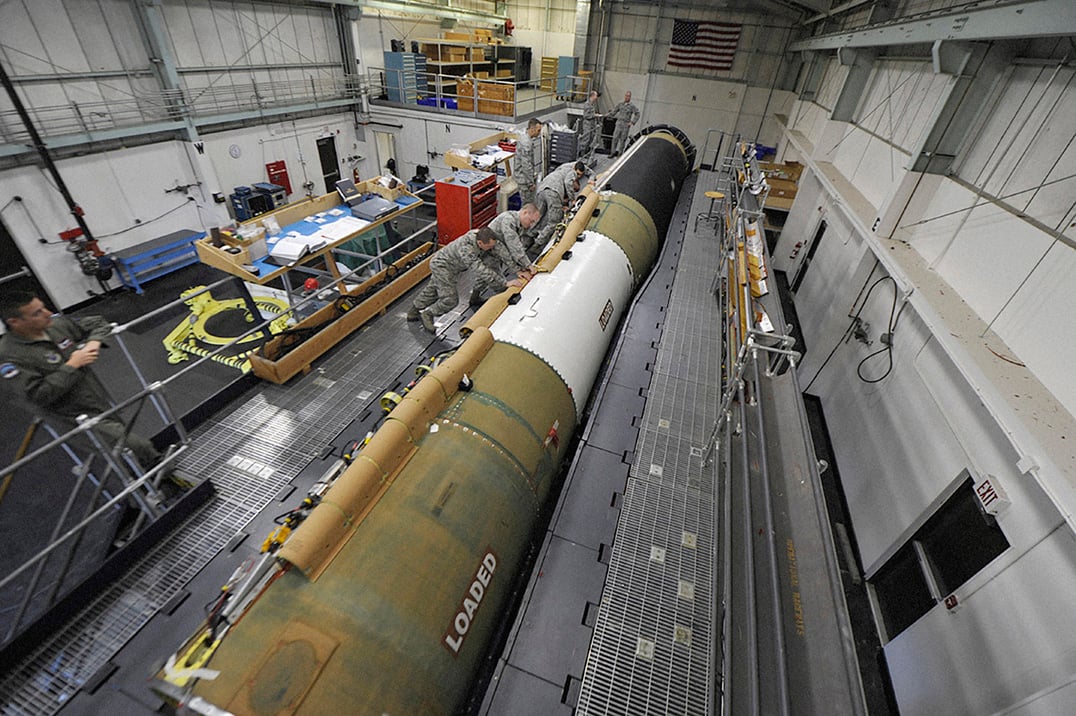Don’t Delay GBSD ICBMs; It’s Too Risky

Airmen install a new cable run on an aging Minuteman III missile.
The Air Force will soon request industry proposals to develop and build the Ground Based Strategic Deterrent (GBSD), the nation’s next Intercontinental Ballistic Missile. The GBSD program will replace Minuteman III missiles first deployed in the 1970s and upgrade their aging launch facilities.
Mark Gunzinger
Russia’s and China’s aggressive nuclear weapons modernization programs prompted the Obama administration to make the long-overdue decision to procure state-of-the-art GBSDs. They should begin to join the inventory in the late 2020s and operate into the 2070s. Some persistent critics of modernizing the U.S. nuclear triad have called to delay or even terminate the GBSD in favor of another extension of the Minuteman III’s service life. Arguments for doing so do not make strategic, technical, or economic sense. In effect, a GBSD program slip or cancellation would be tantamount to a decision to unilaterally giving up one leg of our nation’s triad.
The nation’s ICBM force of 400 operationally deployed Minuteman IIIs and 45 launch centers dispersed over five states provides a unique set of capabilities to deter adversaries from credibly threatening or confidently planning a nuclear strike. Without it, an adversary would only need to attack three bomber bases and two submarine bases to eliminate most of the remaining U.S. nuclear force, thus increasing its incentive to consider a disarming first strike in a crisis.
A variety of factors mandate fielding the replacement. First, the Pentagon is rightfully concerned about the effectiveness of an ICBM designed half a century ago. Missile defenses are now more difficult to penetrate, cyber threats are increasing, and electronic warfare and directed energy weapons pose new challenges to the Minuteman III’s survivability. The need for additional targeting flexibility will also increase as nuclear proliferation continues. The 2018 Nuclear Posture Review put it starkly: “The Minuteman III service life cannot be extended further… In addition, Minuteman III will have increasing difficulty penetrating future adversary defenses.”
A U.S. Air Force Minuteman III intercontinental ballistic missile launches during an operational test May 3, 2017
Second, the solid rocket fuel in the Minuteman III’s lower stages will degrade by the 2030 timeframe, thus requiring them to be scrubbed and refueled. Based on previous life extension programs, some of these stages may not fit together after this process and would need to be replaced. This is a significant concern, since no one makes these any more. The Minuteman III’s third stage, which is constructed of composite materials, cannot be washed out and would also need to be replaced. Moreover, a GBSD program delay would require the Air Force to replace critical components in the Minuteman III’s guidance system that will reach the end of their service lives. These and other efforts to maintain the Minuteman III beyond its scheduled replacement date would cost billions. More importantly, they would not meet DoD’s future requirements.
Third, delaying the GBSD does not make economic sense. New ICBMs will begin to enter service before the Minuteman III becomes unserviceable. A GBSD delay would require spending billions of dollars on band-aid fixes to maintain the Minuteman III, despite analysis provided to Congress that it would actually cost less to buy and sustain the GBSD over time.
Finally, life extension programs would not resolve the impending Minuteman III inventory shortfall. There are now approximately 500 Minuteman III missiles. To ensure the aging weapon system works, the Air Force conducts four to five test launches per year. Should the GBSD be delayed, a combination of test launches and attrition driven by parts obsolescence will deplete the Minuteman III inventory to the point that it will not sustain a force of 400 operationally deployed missiles.
In summary, keeping the Minuteman III in the force beyond its planned replacement date would not provide the capabilities needed for 21st century deterrence, could cost more than the GBSD, and would be tantamount to unilaterally giving up one leg of the triad by neglect. The lack of a credible ICBM force could also reduce the willingness of Russia and China to engage in future arms control negotiations. Keeping the GBSD program on schedule would avoid these risks and ensure the ICBM leg of the U.S. triad remains viable for the next six decades.
Mark Gunzinger, former deputy assistant secretary of Defense for forces transformation and resources, is the new director for government programs and wargaming at the Mitchell Institute for Aerospace Studies.